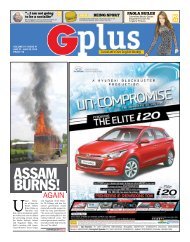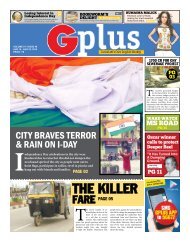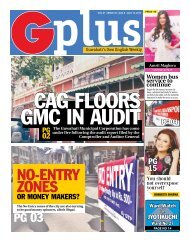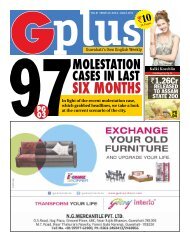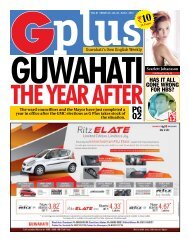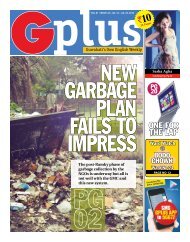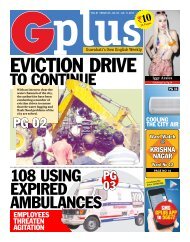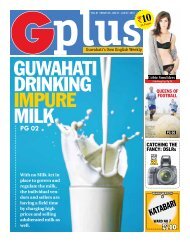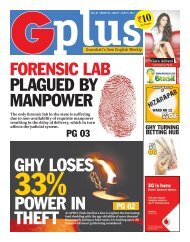Issue 12
Create successful ePaper yourself
Turn your PDF publications into a flip-book with our unique Google optimized e-Paper software.
6<br />
City<br />
VOX POP<br />
Poor Roads<br />
pcos: lost<br />
in time<br />
GPLUS SEP 14 - SEP 20, 2013<br />
Lanes and by-lanes have been dug up to install pipes for the water supply project. But<br />
once the installation is over, the dug up lanes are not repaired properly leading to bad<br />
roads and harassments for pedestrians and vehicle owners alike.<br />
With the promise of providing the citizens an unending supply of water, the GMDA made it a point to<br />
install pipes all over the city in every lane and bye-lane as per the plan. The project looks promising<br />
but the aftermath of the installation has been quite grim because now, the conditions of the roads are<br />
deplorable. There are big potholes, which get worse with daily traffic and footfall. The root of problem has probably<br />
been the fact that a proper thought was not followed while the project was being worked upon and this has<br />
led to a set of disarrayed moves. It is not sure whether we shall get proper water supply in the near future but we<br />
can be sure that we will have a hard time to deal with this situation of bad roads for some time to come.<br />
Siba Dowerah, Senior Citizen<br />
As far as I know, the pipes were installed by Gammon India. However, after installation,<br />
they are supposed to repair them, but nothing has been done so far. Renovation work should<br />
be executed fast otherwise it will have an adverse affect in the long run. Moreover, it was also<br />
the responsibility of the GMDA to re-construct the roads but the progress looks too slow.<br />
In the pursuit of a single benefit, many other problems have cropped up for the citizens as a<br />
whole.<br />
Shahnaz Zaman Choudhury, Post Graduation Student<br />
The conditions of the roads are pathetic. Initially, the news of water supply to every corner<br />
of the city seemed very interesting, in fact it still is, but that the people would have to suffer<br />
was never a thought that could come to mind. Now this poor condition of the roads is a harassment<br />
for every citizen and the promises made before the GMC elections have faded away.<br />
Bibhas Nath, Graphic Designer<br />
The locality I live in has become very muddy. During this monsoon, the roads were in<br />
the worst conditions as even the good roads were excavated to fit these water-supply pipes. In<br />
some areas, the craters have become so deep that it is hard to notice them and have become a<br />
risk to pedestrians and vehicles.<br />
Kristina Dowerah, Student<br />
Low maintenance of the drainage system is another reason for such conditions of the<br />
roads. Had the drains been properly maintained, the problem of stagnant water would not<br />
have been there. During rainy days it becomes really difficult to commute as these roads are<br />
flooded with water and we have no option other than to take rickshaws to avoid walking<br />
through these roads. When can we expect some precautionary measures from the government?<br />
Nayan Jyoti Dutta, Student<br />
The main reasons for this condition of the streets are poor planning strategies and execution<br />
of work. The people are harassed as I believe nobody is ready to take any responsibility of<br />
re-building the roads and in the process, we have to face trouble most of the time.<br />
. . . . . . . . . . . . . . . . . . . . . . . . . . . . . . . . . . . . . . . . . . . . . . . . . . . . . . . . . . . . . . . . . . . . . . . . . . . . . . . . . . . . . . . . . . . . . . . . . . . . . . . . . . . . . . . . . . . . . . . . . . .<br />
Well, the traffic<br />
is really<br />
taking a toll on<br />
me. Nowadays, to reach somewhere<br />
on time is like a rare fruit enjoyed in the b l a z i n g<br />
summer sun. Well, at least it has given me plenty of time to observe<br />
my surroundings and enjoy music, which I like the best. Guwahati<br />
is changing or should I say trying, to lap up to ‘development’. It is<br />
trying to structure itself after a metropolitan city.<br />
As the music pounds my eardrums and Maroon five jar my<br />
senses with “I am at a payphone, trying to call home…” wait payphones?<br />
Who uses payphones nowadays? Yes, suddenly I asked myself<br />
- where are the payphones?<br />
Remember those cute little booths, with the fixed-line phones<br />
- the PCOs? Those red and yellow phones with a slot to for a rupee<br />
coin; the hassle for the one rupee coins. Where are they now? It<br />
was once the most lucrative small or side businesses for many and<br />
a mainstay of Guwahati’s city scape. It was fascinating how once<br />
shopkeepers, dhabas, salons, doctors and restaurants across places<br />
like Ganeshguri, Bhangagarh, Chnadmari, Beltola Maligoan and<br />
all used to place a payphone or a small booth outside their establishment<br />
just to earn that little extra money. The PCO or the Public<br />
Call Offices which was considered an essential service, enabling<br />
easy communication and connected so many people is now battling<br />
for survival or, should I say, has become an ‘endangered species’<br />
of communication.<br />
The very next day, I searched for a PCO or even a payphone<br />
would do, but it was in vain. True, I didn’t search every corner of<br />
Guwahati, but I ran through most of the places. Beaten, I decide to<br />
start at my locality which was once teeming with those little booths<br />
and the red and yellow phones, where there was always a gaggle of<br />
people having their evening quota of ‘addas’. I approached our local<br />
shopkeeper who I remember used to own a then trendy PCO. I<br />
asked him the obvious question and his response was, “Bhonty aji<br />
kali aru kot PCO paba… mobile’or zamaanat.”<br />
The PCOs started to thrive in the early 90s and took the telephone<br />
out of the private domains into the public space. I talked to a<br />
neighbour of mine who’s now well in her fifties and a lecturer of an<br />
established college. She narrated to me the valuable role of PCO’s in<br />
her life when her husband was transferred to another city and she<br />
was stuck in Guwahati because of her work. “It was, I guess in 1986,<br />
when my husband was transferred to Hyderabad and I had to wait<br />
at our neighbour’s house to receive his calls. But with the coming<br />
of public phones, all that changed and I could make as many calls<br />
as I wanted. Now with cell phones, you won’t understand the value<br />
of those public phones.”<br />
With the mobile phones a rage and accessible to every level of<br />
society, the Public Call Office was forced to call it quits making<br />
the city lose one of its prominent attributes. The infiltration of cell<br />
phones and the appealing rates offered by the different service providers<br />
has lead to the declining use of PCO’s all over the country.<br />
The Telecom Regulatory Authority of India, stated that the decline<br />
has been more evident since 2006, with about 2.6 lakhs PCO booths<br />
in the country being shut during September-December 2008 alone.<br />
Mobile phones are handy and are here to stay. But today’s adolescents,<br />
teenagers and youth would never understand the charm of<br />
a PCO. Those much anticipated, planned STD calls, the luxuries of<br />
making an ISD call, calling your crushes in secret, making blank<br />
calls for the pleasure of it and mostly, how it felt like to talk for<br />
a limited time and yet having a satisfying conversation. And yes,<br />
paying for your calls. It all signifies the passing of an era.<br />
CITIZEN JOURNALIST<br />
Yashomana Choudhary<br />
YOU CAN BE A CITIZEN JOURNALIST TOO.<br />
Just mail us your story at editor@g-plus.in




